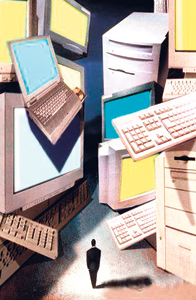
Technology in conservationOne of the more notable media events of 2007 was the coming of age of 'global warming' which after decades of being confined to documentaries in Discovery Channel, suddenly became a marketable – and highly profitable – commodity in popular media. The threats that were posed by a possible warming up of the planet were rarely disputed, but the possible and most likely causes have become a hot political issue. Nevertheless, given the implications of global warming for the planet, it's time that everyone got serious about reducing our carbon footprint 'from a pair of size 13 boots to size 5 sandals.’ Saving the planet however is a complicated business these days, and as it has done with most types of complicated businesses, Information Technology is in a position to make a healthy contribution to the whole process involving the reduction of carbon emissions into the atmosphere.
It is easy when we are discussing a topic as complicated and seemingly boundless in its scope as 'reducing carbon emissions' to think of the obvious and large scale factors such as energy efficiency and emission offsets and lose sight of the simple daily contributions that individuals can make. Information Communication Technology has opened up new possibilities to reduce carbon emissions – a video conference will definitely save a significant amount of carbon (not to mention fuel costs) than taking a drive or flight to a meeting, but our focus on technology has shifted attention away from factors related to human behaviour that can be altered for significant environmental benefits. For example, studies have shown that by reducing the font size by two points in the documents you print at the office, university or even at home, and using duplex printing wherever it is available and practicable, it is possible to reduce our paper consumption by about 40%. If you can't use duplex printing, it may certainly be possible to recycle the blank side of used printer paper around the office or for rough notes at school or university. Shutting down your computer and other office equipment (instead of just logging off) when you leave the office, will surely save a considerable amount of energy. Write to us at technopage@gmail.com and share your ideas for a greener, cooler world in 2008, which we hope and wish will be a peaceful year for all our readers. Improve your computer literacy Green computing Also called green computing, Green IT describes the study and the using of computer resources in an efficient way. Green IT starts with manufacturers producing environmentally friendly products and encouraging IT departments to consider more friendly options like virtualization, power management and proper recycling habits. The government has also recently proposed new compliance regulations which would work towards certifying data centres as green. Some criteria include using low-emission building materials, recycling, using alternative energy technologies, and other green technologies. Tit bits Elizabeth 2.0 Potential tourists who had their plans of visiting London quashed by the strong pound can take some solace in the fact that it won't prevent them from catching a glimpse of the city's most famous resident. Queen Elizabeth II has launched her own YouTube website, " The Royal Channel", complete with old news clips and speeches, glimpses inside Buckingham Palace and a day in the life of several members of the royal family. Buckingham Palace said the 81-year-old queen, who became Britain's oldest ever monarch last week after more than half a century on the throne, was hoping to reach a wider, and younger, audience by creating a permanent presence for herself on the popular video-sharing network, owned by Google. iOrder Steve Jobs, CEO at Apple is reportedly seeking to patent a wireless system that would allow customers to place an order at a store or coffee shop using a wireless device such as a media player, a wireless personal digital assistant or a cell phone. Apple describes the system as a process that places an order and then notifies customers when an order is ready to grab at a pick-up station. One goal, the patent application notes, is to avoid an "annoying wait in a long queue if the purchaser arrives before completion of the order." If the proposal becomes the product, each customer using the system would be given a unique identifier for tracking the locations they visited and also what they bought from the store. The information would be stored in the devices and synchronized with the computers of participating merchants. |
|| Front
Page | News | Editorial | Columns | Sports | Plus | Financial
Times | International | Mirror | TV
Times | Funday
Times || |
| |
Reproduction of articles permitted when used without any alterations to contents and the source. |
© Copyright
2008 | Wijeya
Newspapers Ltd.Colombo. Sri Lanka. All Rights Reserved. |
